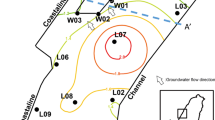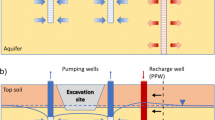Abstract
A groundwater flow and mass transport model tested the capability of shallow excavations filled with coarse, reactive media to remediate a hypothetical unconfined aquifer with a maximum saturated thickness of 5 m. Modeled as contaminant sinks, the rectangular excavations were 10 m downgradient of an initial contaminant plume originating from a source at the top of the aquifer. The initial plume was approximately 259 m long, 23 m wide, and 5 m thick, with a downgradient tip located approximately 100 m upgradient of the site boundary. The smallest trench capable of preventing offsite migration was 11 m long (measured perpendicular to groundwater flow), 4 m wide (measured parallel to groundwater flow), and 3 m deep. Results of this study suggest that shallow trenches filled with coarse filter media that partially penetrate unconfined aquifers may be a viable alternative for remediating contaminated groundwater at some sites.



Similar content being viewed by others
References
API (American Petroleum Institute) (1989) Hydrogeologic database for ground water modeling. American Petroleum Institute, Publication 4476, Washington, D.C
Bilbrey LC, Shafer JM (2001) Funnel-and-gate performance in a moderately heterogeneous flow domain. Ground Water Monit Remediat 21(3):144–151
Blowes DW, Ptacek CJ, Benner SG, McRae CWT, Puls RW (2000) Treatment of inorganic contaminants using permeable reactive barriers. J Contam Hydrol 45(1):123–137
Bortone I, Di Nardo A, Di Natale M, Erto A, Musmarra D, Santonastaso GF (2013) Remediation of an aquifer polluted with dissolved tetrachloroethylene by an array of wells filled with activated carbon. J Hazard Mater 260:914–920
Cirpka OA, Burger CM, Nowak W, Finkel M (2004) Uncertainty and data worth analysis for the hydraulic design of funnel-and-gate systems in heterogeneous aquifers. Water Resour Res 40(11):1–12. (W11502)
Elder CR, Benson CH, Eykholt GR (2002) Effects of heterogeneity on influent and effluent concentration from horizontal permeable reactive barriers. Water Resour Res 38(8):1152
Eykholt GR, Elder CR, Benson CH (1999) Effects of aquifer heterogeneity and reaction mechanism uncertainty on a reactive barrier. J Hazard Mater 68(1):73–96
Gavaskar AR (1999) Design and construction techniques for permeable reactive barriers. J Hazard Mater 68(1):41–71
Guerin TF, Horner S, McGovern T, Davey B (2002) An application of permeable reactive barrier technology to petroleum hydrocarbon contaminated groundwater. Water Res 36(1):15–24
Gupta N, Fox TC (1999) Hydrogeologic modeling for permeable reactive barriers. J Hazard Mater 68(1):19–39
Hemsi PS, Shackelford CD (2006) An evaluation of the influence of aquifer heterogeneity on permeable reactive barrier design. Water Resour Res 42:W03402. https://doi.org/10.1029/2005WR004629
Hudak PF (2005) Effect of setback distance on ability of gravel trenches to intercept contaminated groundwater. Environ Monit Assess 104:419–423
Hudak PF (2007) Mass transport in groundwater near hanging-wall interceptors. J Environ Sci Health 42:317–321
Lai KCK, Lo IMC, Birkelund V, Kjeldsen P (2006) Field monitoring of a permeable reactive barrier for removal of chlorinated organics. J Environ Eng 132(2):199–210
Mayer KU, Benner SG, Blowes DW (2006) Process-based reactive transport modeling of a permeable reactive barrier for the treatment of mine drainage. J Contam Hydrol 85(3-4):195–211
Mayer KU, Blowes DW, Frind EO (2001) Reactive transport modeling on an in situ reactive barrier for the treatment of hexavalent chromium and trichloroethylene in groundwater. Water Resour Res 37(12):3091–3104
McGovern T, Guerin TF, Horner S, Davey B (2002) Design, construction, and operation of a funnel and gate in-situ permeable reactive barrier for remediation of petroleum hydrocarbons in groundwater. Water Air Soil Pollut 136:11–31
McMurtry DC, Elton RO (1985) New approach to in situ treatment of contaminated ground waters. Environ Progress 4(3):168–170
Murdoch LS (1994) Transient analysis of an interceptor trench. Water Resour Res 30(11):3023
Painter BDM (2004) Reactive barriers: Hydraulic performance and design enhancements. Ground Water 42(4):609–619
Sedivy RA, Shafer JM, Bilbrey LC (1999) Design screening tools for passive funnel and gate systems. Ground Water Monit Remediat 19(4):125–133
Starr RC, Cherry JA (1994) In situ remediation of contaminated ground water: The funnel-and-gate system. Ground Water 32(3):465–476
Striegel J, Sanders DA, Veenstra JN (2001) Treatment of contaminated groundwater using permeable reactive barriers. Environ Geosci 8(4):258–265
USGS (U.S. Geological Survey) (1999) Deep aquifer remediation tools (DARTs): A new technology for ground-water remediation. U.S. Geological Survey Fact Sheet 156-9. U.S. Geological Survey, Reston, Virginia
Wilson RD, Mackay DM, Cherry JA (1997) Arrays of unpumped wells for plume migration control by semi-passive in situ remediation. Ground Water Monit Remediat 17:185–93
Zheng C (1999) MT3D: A modular three-dimensional transport model for simulation of advection, dispersion and chemical reactions of contaminants in groundwater systems. S.S. Papadopulos and Associates, Rockville, Maryland
Acknowledgements
The University of North Texas provided office space and computing resources for this project.
Author information
Authors and Affiliations
Corresponding author
Ethics declarations
Conflict of interest
The authors declare that they have no conflict of interest.
Rights and permissions
About this article
Cite this article
Hudak, P.F. Remediating Contaminant Plumes in Groundwater with Shallow Excavations Containing Coarse Reactive Media. Environmental Management 61, 304–309 (2018). https://doi.org/10.1007/s00267-017-0977-2
Received:
Accepted:
Published:
Issue Date:
DOI: https://doi.org/10.1007/s00267-017-0977-2




